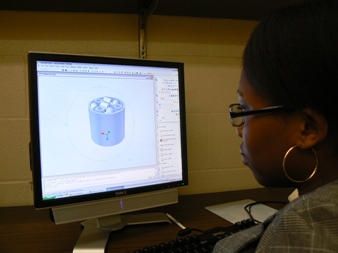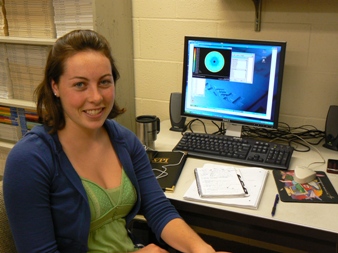|
The machines available in the lab change as more powerful facilities are acquired. One of our first
computers, a DEC Alpha, was bought in 1997 and was the first full workstation in our lab used
exclusively for CFD, running Windows NT version 4.0. With 512 MB of RAM and using the Fluent CFD Package
we could tackle a 44-sphere simulation of a tube with over 250,000 control volumes.

We use GAMBIT model-building and meshing software to construct the geometries for our models of packed tubes. The
scripting facilities in that package are necessary for the repetitive placement of hundreds or thousands of spheres
in our tube models. Cylindrical packings are more difficult, and we have experimented with AutoCAD, SolidWorks and
other packages to more easily manipulate the packing cylinders. The model is then imported into
GAMBIT to fine tune the structure and mesh it ready for solution in Fluent. Here on the right 2008 summer student
Winnie Nabea contemplates her latest attempt at a 2-inch tube packed with 1/2-inch Raschig rings in AutoCAD.

Once the models have been built and meshed, they are imported into Fluent CFD software for solution and post-processing.
The memory in our desktop workstations, 2 GB, with Windows XP Pro operating system, only allows geometries to be handled up
to approximately 6 million control volumes, when using a turbulent model including energy equations. For larger models,
or for faster running times, we run in batch mode on Linux servers (see description below). Here on the left 2008 summer student
Amanda Gurnon is working on display of results from a relatively small 72-sphere conduction heat transfer simulation using
15 million cells.
Our group currently has two PowerEdge 610 servers available exclusively for CFD work. One has two quad-core 2.93 GHz processors
with 48 GB RAM, the other has twin 6-core 3.46 GHz processors with 64 GB RAM. These have so far allowed us to construct and mesh
CFD models with up to 1250 spheres, using 42 million control volumes. We also own three Sun Microsystems SunFire X2200 M2 x64 Servers, each comprised of two AMD Opteron
Model 2218 dual core 2.6 GHz processors with 8 GB of RAM, a 250-GB hard drive, which we are going to combine to make a 12-core cluster
with 24 GB RAM and use for undergraduate projects. All systems are presently running Gambit64 under a Linux operating system. Various
other high-performance computing facilities are available on campus for students to use in this work.
|


